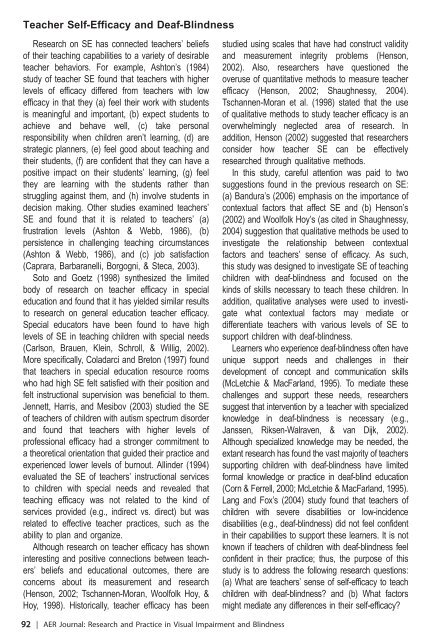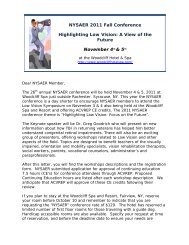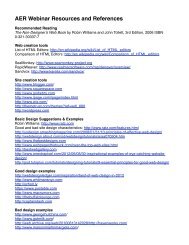Association for Education and Rehabilitation of the ... - AER Online
Association for Education and Rehabilitation of the ... - AER Online
Association for Education and Rehabilitation of the ... - AER Online
You also want an ePaper? Increase the reach of your titles
YUMPU automatically turns print PDFs into web optimized ePapers that Google loves.
Teacher Self-Efficacy <strong>and</strong> Deaf-Blindness<br />
Research on SE has connected teachers’ beliefs<br />
<strong>of</strong> <strong>the</strong>ir teaching capabilities to a variety <strong>of</strong> desirable<br />
teacher behaviors. For example, Ashton’s (1984)<br />
study <strong>of</strong> teacher SE found that teachers with higher<br />
levels <strong>of</strong> efficacy differed from teachers with low<br />
efficacy in that <strong>the</strong>y (a) feel <strong>the</strong>ir work with students<br />
is meaningful <strong>and</strong> important, (b) expect students to<br />
achieve <strong>and</strong> behave well, (c) take personal<br />
responsibility when children aren’t learning, (d) are<br />
strategic planners, (e) feel good about teaching <strong>and</strong><br />
<strong>the</strong>ir students, (f) are confident that <strong>the</strong>y can have a<br />
positive impact on <strong>the</strong>ir students’ learning, (g) feel<br />
<strong>the</strong>y are learning with <strong>the</strong> students ra<strong>the</strong>r than<br />
struggling against <strong>the</strong>m, <strong>and</strong> (h) involve students in<br />
decision making. O<strong>the</strong>r studies examined teachers’<br />
SE <strong>and</strong> found that it is related to teachers’ (a)<br />
frustration levels (Ashton & Webb, 1986), (b)<br />
persistence in challenging teaching circumstances<br />
(Ashton & Webb, 1986), <strong>and</strong> (c) job satisfaction<br />
(Caprara, Barbaranelli, Borgogni, & Steca, 2003).<br />
Soto <strong>and</strong> Goetz (1998) syn<strong>the</strong>sized <strong>the</strong> limited<br />
body <strong>of</strong> research on teacher efficacy in special<br />
education <strong>and</strong> found that it has yielded similar results<br />
to research on general education teacher efficacy.<br />
Special educators have been found to have high<br />
levels <strong>of</strong> SE in teaching children with special needs<br />
(Carlson, Brauen, Klein, Schroll, & Willig, 2002).<br />
More specifically, Coladarci <strong>and</strong> Breton (1997) found<br />
that teachers in special education resource rooms<br />
who had high SE felt satisfied with <strong>the</strong>ir position <strong>and</strong><br />
felt instructional supervision was beneficial to <strong>the</strong>m.<br />
Jennett, Harris, <strong>and</strong> Mesibov (2003) studied <strong>the</strong> SE<br />
<strong>of</strong> teachers <strong>of</strong> children with autism spectrum disorder<br />
<strong>and</strong> found that teachers with higher levels <strong>of</strong><br />
pr<strong>of</strong>essional efficacy had a stronger commitment to<br />
a <strong>the</strong>oretical orientation that guided <strong>the</strong>ir practice <strong>and</strong><br />
experienced lower levels <strong>of</strong> burnout. Allinder (1994)<br />
evaluated <strong>the</strong> SE <strong>of</strong> teachers’ instructional services<br />
to children with special needs <strong>and</strong> revealed that<br />
teaching efficacy was not related to <strong>the</strong> kind <strong>of</strong><br />
services provided (e.g., indirect vs. direct) but was<br />
related to effective teacher practices, such as <strong>the</strong><br />
ability to plan <strong>and</strong> organize.<br />
Although research on teacher efficacy has shown<br />
interesting <strong>and</strong> positive connections between teachers’<br />
beliefs <strong>and</strong> educational outcomes, <strong>the</strong>re are<br />
concerns about its measurement <strong>and</strong> research<br />
(Henson, 2002; Tschannen-Moran, Woolfolk Hoy, &<br />
Hoy, 1998). Historically, teacher efficacy has been<br />
92 | <strong>AER</strong> Journal: Research <strong>and</strong> Practice in Visual Impairment <strong>and</strong> Blindness<br />
studied using scales that have had construct validity<br />
<strong>and</strong> measurement integrity problems (Henson,<br />
2002). Also, researchers have questioned <strong>the</strong><br />
overuse <strong>of</strong> quantitative methods to measure teacher<br />
efficacy (Henson, 2002; Shaughnessy, 2004).<br />
Tschannen-Moran et al. (1998) stated that <strong>the</strong> use<br />
<strong>of</strong> qualitative methods to study teacher efficacy is an<br />
overwhelmingly neglected area <strong>of</strong> research. In<br />
addition, Henson (2002) suggested that researchers<br />
consider how teacher SE can be effectively<br />
researched through qualitative methods.<br />
In this study, careful attention was paid to two<br />
suggestions found in <strong>the</strong> previous research on SE:<br />
(a) B<strong>and</strong>ura’s (2006) emphasis on <strong>the</strong> importance <strong>of</strong><br />
contextual factors that affect SE <strong>and</strong> (b) Henson’s<br />
(2002) <strong>and</strong> Woolfolk Hoy’s (as cited in Shaughnessy,<br />
2004) suggestion that qualitative methods be used to<br />
investigate <strong>the</strong> relationship between contextual<br />
factors <strong>and</strong> teachers’ sense <strong>of</strong> efficacy. As such,<br />
this study was designed to investigate SE <strong>of</strong> teaching<br />
children with deaf-blindness <strong>and</strong> focused on <strong>the</strong><br />
kinds <strong>of</strong> skills necessary to teach <strong>the</strong>se children. In<br />
addition, qualitative analyses were used to investigate<br />
what contextual factors may mediate or<br />
differentiate teachers with various levels <strong>of</strong> SE to<br />
support children with deaf-blindness.<br />
Learners who experience deaf-blindness <strong>of</strong>ten have<br />
unique support needs <strong>and</strong> challenges in <strong>the</strong>ir<br />
development <strong>of</strong> concept <strong>and</strong> communication skills<br />
(McLetchie & MacFarl<strong>and</strong>, 1995). To mediate <strong>the</strong>se<br />
challenges <strong>and</strong> support <strong>the</strong>se needs, researchers<br />
suggest that intervention by a teacher with specialized<br />
knowledge in deaf-blindness is necessary (e.g.,<br />
Janssen, Riksen-Walraven, & van Dijk, 2002).<br />
Although specialized knowledge may be needed, <strong>the</strong><br />
extant research has found <strong>the</strong> vast majority <strong>of</strong> teachers<br />
supporting children with deaf-blindness have limited<br />
<strong>for</strong>mal knowledge or practice in deaf-blind education<br />
(Corn & Ferrell, 2000; McLetchie & MacFarl<strong>and</strong>, 1995).<br />
Lang <strong>and</strong> Fox’s (2004) study found that teachers <strong>of</strong><br />
children with severe disabilities or low-incidence<br />
disabilities (e.g., deaf-blindness) did not feel confident<br />
in <strong>the</strong>ir capabilities to support <strong>the</strong>se learners. It is not<br />
known if teachers <strong>of</strong> children with deaf-blindness feel<br />
confident in <strong>the</strong>ir practice; thus, <strong>the</strong> purpose <strong>of</strong> this<br />
study is to address <strong>the</strong> following research questions:<br />
(a) What are teachers’ sense <strong>of</strong> self-efficacy to teach<br />
children with deaf-blindness? <strong>and</strong> (b) What factors<br />
might mediate any differences in <strong>the</strong>ir self-efficacy?







